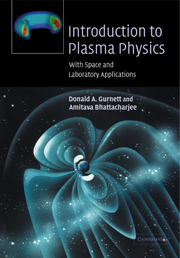Book contents
- Frontmatter
- Contents
- Preface
- 1 Introduction
- 2 Characteristic parameters of a plasma
- 3 Single particle motions
- 4 Waves in a cold plasma
- 5 Kinetic theory and the moment equations
- 6 Magnetohydrodynamics
- 7 Discontinuities and shock waves
- 8 Electrostatic waves in a hot unmagnetized plasma
- 9 Waves in a hot magnetized plasma
- 10 Non-linear effects
- 11 Collisional processes
- Appendix A Symbols
- Appendix B Vector differential operators
- Appendix C Vector calculus identities
- Index
- References
10 - Non-linear effects
Published online by Cambridge University Press: 05 June 2012
- Frontmatter
- Contents
- Preface
- 1 Introduction
- 2 Characteristic parameters of a plasma
- 3 Single particle motions
- 4 Waves in a cold plasma
- 5 Kinetic theory and the moment equations
- 6 Magnetohydrodynamics
- 7 Discontinuities and shock waves
- 8 Electrostatic waves in a hot unmagnetized plasma
- 9 Waves in a hot magnetized plasma
- 10 Non-linear effects
- 11 Collisional processes
- Appendix A Symbols
- Appendix B Vector differential operators
- Appendix C Vector calculus identities
- Index
- References
Summary
In this chapter we give a brief introduction to various types of non-linear effects that can occur in a plasma. Almost all of the basic equations in plasma physics have non-linear terms. For example, these include the (E + v × B) · ∇vf term in the Vlasov equation (5.2.15), the U · ∇U term in the convective derivative (5.4.26), the ρmU term in the MHD mass continuity equation (6.1.32), and the J × B term in the MHD momentum equation (6.1.33). All of these terms represent potential sources of non-linear effects. There are many more. In our analysis of waves in the previous chapters, we always assumed that the wave amplitude was small, so that the governing equations can be linearized. This assumption provides a remarkably accurate description of many types of small amplitude waves. However, if the wave amplitude becomes large, as always occurs for an instability, the linearization assumption breaks down. Non-linear effects must then be taken into account. There are many such non-linear effects, more than we can possibly discuss in this introductory textbook. In order to limit the scope of the discussion, we will concentrate on two quite different types of non-linear analyses that have a wide range of applications. These are (1) quasi-linear theory, and (2) time-stationary electrostatic potentials. For a more comprehensive discussion of non-linear effects in plasmas, the reader is referred to one of the specialized books on non-linear effects, such as Kadomtsev [1965], Sagdeev and Galeev [1969], and Davidson [1972].
- Type
- Chapter
- Information
- Introduction to Plasma PhysicsWith Space and Laboratory Applications, pp. 391 - 414Publisher: Cambridge University PressPrint publication year: 2005



